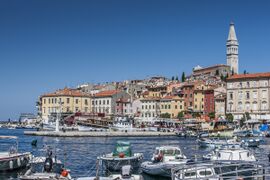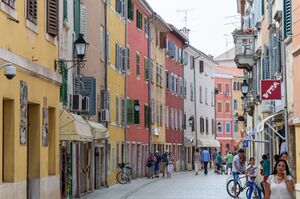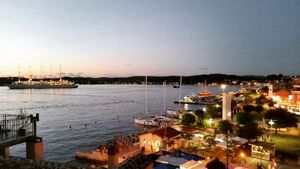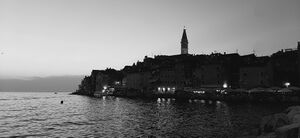روڤينيْ
Rovinj
| |
|---|---|
| Grad Rovinj Città di Rovigno[1] City of Rovinj | |
Rovinj | |
| الإحداثيات: 45°05′N 13°38′E / 45.083°N 13.633°E | |
| Country | |
| County | |
| الحكومة | |
| • العمدة | Marko Paliaga (IDS)[2] |
| • City Council | 17 members
|
| المساحة | |
| • City | 29٫9 ميل² (77٫5 كم²) |
| • الحضر | 24٫1 ميل² (62٫5 كم²) |
| المنسوب | 0 ft (0 m) |
| التعداد (2021)[4] | |
| • City | 12٬968 |
| • الكثافة | 430/sq mi (170/km2) |
| • Urban | 11٬629 |
| • الكثافة الحضرية | 480/sq mi (190/km2) |
| منطقة التوقيت | UTC+1 (CET) |
| • الصيف (التوقيت الصيفي) | UTC+2 (CEST) |
| Postal code | 52210 |
| مفتاح الهاتف | 052 |
| الموقع الإلكتروني | rovinj-rovigno |
روڤينيْ (Rovinj ؛ صربو-كرواتية: [rǒʋiːɲ]; Venetian and Italian: Rovigno; Istriot: Ruvèigno or Ruveîgno; باليونانية قديمة: Ρυγίνιον, Rygínion; لاتينية: Ruginium) is a city in west Croatia situated on the north Adriatic Sea with a population of 14,294 (2011). Located on the western coast of the Istrian peninsula, it is a popular tourist resort and beach destination, in addition to being an active fishing port. Istriot, a Romance language once widely spoken in this part of Istria, is still spoken by some of the residents. The town is officially bilingual, Croatian and Italian, hence both town names are official and equal.[5]
التاريخ

Rovinj-Rovigno was already a settlement of Venetian or Illyrian tribes before being captured by the Romans, who called it Arupinium or Mons Rubineus, and later Ruginium and Ruvinium.[6] Built on an island close to the coast, it became connected to the mainland much later, in 1763, by filling in the channel.[7]
Rovinj-Rovigno was eventually incorporated into the Byzantine Empire, later becoming part of the Exarchate of Ravenna in the 6th century, before being taken over by the Frankish Empire in 788.[8] For the following several centuries it was ruled by a succession of feudal lords, and in 1209 it was acquired by the Patriarchate of Aquileia under Wolfger von Erla.[9]
From 1283 to 1797, Rovinj-Rovigno was one of the most important towns in Istria governed by the Republic of Venice.[10] During this period, three town gates were constructed and Rovinj-Rovigno was fortified by two rows of defensive walls, remains of which can still be seen today.[11] The Rovinj-Rovigno pier is home to one of the old town gates, Balbi's Arch, dating from 1680, and a late-Renaissance clock tower.[12] The first city statute was proclaimed in 1531.[13]
Following the fall of Venice in 1797 and the ensuing Napoleonic interlude, Rovinj-Rovigno became part of the Austrian Empire, which lasted until World War I.[14] According to the last Austrian census in 1911, 97.8% of the population was Italian-speaking. Rovinj-Rovigno then belonged to Kingdom of Italy from 1918 to 1947, when it was ceded to SFR Yugoslavia, as part of SR Croatia. The original town name "Rovigno" was then changed to "Rovinj." During the post-war period, many Italian inhabitants left Rovigno, leading to significant changes in the city's demographic structure.
Following Croatia's independence in 1991, Rovinj-Rovigno became one of the most important centers of Istria County, an administrative unit encompassing most of Istria. Rovinj-Rovigno is today the third most populous town in the county, behind Pula-Pola and Poreč-Parenzo.
المناخ
Rovinj-Rovigno is one of nine settlements officially designated as towns in Istria County in western Croatia. It has a humid subtropical climate (Köppen: Cfa), with an average temperature of 4.8 °C (40.6 °F) in January and 22.3 °C (72.1 °F) in July. The average annual temperature is 13.4 °C (56.1 °F). The sea temperature is more than 20 °C (68 °F) from the mid-June to September. The average annual sea temperature is 16.6 °C (61.9 °F).[15]
From May to September Rovinj-Rovigno receives more than 10 sunshine hours a day.[16] The rainfall averages 941 mm (37.05 in) a year and average air humidity is 72 percent.
Originally the peninsula on which the city lies was an island, separated from the mainland by a channel. The latter was filled in 1763. Rovinj Archipelago includes 22 islets.
| بيانات المناخ لـ روڤينيْ | |||||||||||||
|---|---|---|---|---|---|---|---|---|---|---|---|---|---|
| الشهر | ينا | فب | مار | أبر | ماي | يون | يول | أغس | سبت | أكت | نوف | ديس | السنة |
| القصوى القياسية °س (°ف) | 16.9 (62.4) |
21.3 (70.3) |
22.2 (72.0) |
28.8 (83.8) |
30.0 (86.0) |
36.0 (96.8) |
35.1 (95.2) |
37.1 (98.8) |
32.0 (89.6) |
27.6 (81.7) |
21.6 (70.9) |
16.7 (62.1) |
37.1 (98.8) |
| متوسط القصوى اليومية °س (°ف) | 9.6 (49.3) |
10.6 (51.1) |
13.4 (56.1) |
16.7 (62.1) |
21.7 (71.1) |
25.4 (77.7) |
28.5 (83.3) |
28.7 (83.7) |
24.6 (76.3) |
19.9 (67.8) |
14.4 (57.9) |
10.8 (51.4) |
18.7 (65.7) |
| المتوسط اليومي °س (°ف) | 5.3 (41.5) |
5.5 (41.9) |
8.1 (46.6) |
11.5 (52.7) |
16.4 (61.5) |
20.1 (68.2) |
22.8 (73.0) |
22.4 (72.3) |
18.4 (65.1) |
14.2 (57.6) |
9.6 (49.3) |
6.5 (43.7) |
13.4 (56.1) |
| متوسط الدنيا اليومية °س (°ف) | 1.8 (35.2) |
1.6 (34.9) |
4.0 (39.2) |
7.1 (44.8) |
11.6 (52.9) |
14.9 (58.8) |
17.2 (63.0) |
17.2 (63.0) |
14.0 (57.2) |
10.2 (50.4) |
6.0 (42.8) |
3.2 (37.8) |
9.1 (48.4) |
| الصغرى القياسية °س (°ف) | −14.8 (5.4) |
−8.8 (16.2) |
−10.0 (14.0) |
−1.0 (30.2) |
0.6 (33.1) |
5.4 (41.7) |
7.3 (45.1) |
8.2 (46.8) |
4.0 (39.2) |
−1.5 (29.3) |
−6.4 (20.5) |
−9.4 (15.1) |
−14.8 (5.4) |
| متوسط تساقط الأمطار mm (inches) | 59.5 (2.34) |
50.3 (1.98) |
55.0 (2.17) |
63.3 (2.49) |
56.4 (2.22) |
72.1 (2.84) |
40.7 (1.60) |
64.5 (2.54) |
83.1 (3.27) |
97.0 (3.82) |
98.3 (3.87) |
71.2 (2.80) |
811.5 (31.95) |
| Average precipitation days (≥ 0.1 mm) | 8.8 | 7.4 | 8.1 | 10.5 | 9.7 | 9.0 | 5.8 | 6.6 | 7.9 | 9.8 | 10.0 | 8.5 | 102.0 |
| متوسط الرطوبة النسبية (%) | 82.1 | 78.9 | 75.7 | 74.6 | 74.5 | 70.7 | 67.7 | 70.3 | 76.3 | 79.6 | 80.4 | 81.1 | 76.0 |
| Mean monthly ساعات سطوع الشمس | 102.3 | 138.4 | 176.7 | 201.0 | 269.7 | 288.0 | 328.6 | 303.8 | 231.0 | 176.7 | 108.0 | 93.0 | 2٬417٫2 |
| Source: National Meteorological and Hydrological Service (Croatia)[17] | |||||||||||||
السكان
حسب تعداد 2021، يبلغ عدد سكان روفيني 12,968 نسمة، منهم 11,629 يعيشون في المدينة نفسها. The other settlement in the municipality is Rovinjsko Selo.[4] At the 2011 census it was 14,294 and 13,056 respectively.[18]
| السنة | تعداد | ±% |
|---|---|---|
| 1880 | 10٬100 | — |
| 1890 | 10٬354 | +2.5% |
| 1900 | 11٬042 | +6.6% |
| 1910 | 13٬160 | +19.2% |
| 1921 | 10٬863 | −17.5% |
| 1931 | 11٬069 | +1.9% |
| 1948 | 8٬589 | −22.4% |
| 1953 | 6٬374 | −25.8% |
| 1961 | 7٬818 | +22.7% |
| 1971 | 9٬464 | +21.1% |
| 1981 | 11٬861 | +25.3% |
| 1991 | 13٬559 | +14.3% |
| 2001 | 14٬234 | +5.0% |
| 2011 | 14٬294 | +0.4% |
| 2021 | 12٬968 | −9.3% |
| Source: Naselja i stanovništvo Republike Hrvatske 1857–2001, DZS, Zagreb, 2005 | ||
In the 2011 census, there were 14,294 people living in Rovinj municipality. Croats form the majority at 63.3%, while ethnic minorities include Italians (11.3%), those identifying with regional affiliation (10.5%), Serbs (4.2%), Albanians (2.7%) and Bosniaks (2.1%).[19]
| population | 9891 | 10063 | 10100 | 10354 | 11042 | 13160 | 10863 | 11069 | 8589 | 6374 | 7818 | 9464 | 11861 | 13559 | 14234 | 14294 | 12968 |
| 1857 | 1869 | 1880 | 1890 | 1900 | 1910 | 1921 | 1931 | 1948 | 1953 | 1961 | 1971 | 1981 | 1991 | 2001 | 2011 | 2021 |
City government
The City Assembly is composed of 19 representatives, coming from the following political parties:
- Istrian Democratic Assembly (IDS) 13
- Independent 3
- Social Democratic Party of Croatia (SDP) 2
- Croatian Democratic Union (HDZ) 1
الاقتصاد
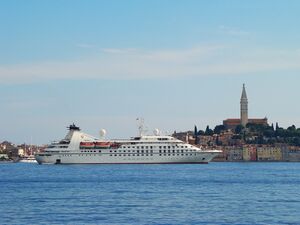
The main economic activity in Rovinj-Rovigno is tourism and during peak season (May–September), its bars, restaurants and art galleries work long hours, while operating limited hours off-season.
The busiest area is the very centre of Rovinj-Rovigno, extending from the main bus station towards the old part of town, where most bars and clubs are located.
The town's main central thoroughfare is the fully pedestrian Carera Street, with many independent shops and art galleries. A farmer's market is located at the edge of the historic part of town, near Valdibora Square.
According to data compiled by Istria Tourist Board, Rovinj-Rovigno is the second biggest tourist destination in the county, in terms of overnight stays. The two closest airports are in Pula-Pola (Croatia) and Trieste (Italy). During the summer season, low-cost airlines, such as Ryanair, operate direct flights from western Europe to both airports. Easyjet operates flights between cities in the United Kingdom and Pula-Pola in the summer months.
There are numerous hotels in the town itself, and beds are abundant though usually overbooked in the summer months. Accommodation ranges from private rooms or apartments to bungalows, camping sites and 2- to 5-star hotels. The city also has three luxury, 5-star hotels: Hotel Monte Mulini, Hotel Lone and Grand Park Hotel Rovinj, all owned by hotel group Maistra.[20] Apart from hotels on the mainland, there are also a handful of hotels on small islands surrounding Rovinj-Rovigno which are linked to the mainland by boats which go from the city centre to the hotel on the islands.
المعالم
- St. Euphemia's Basilica
- Monkodonja
- Zlatni Rt Forest Park
- The Rovinj-Rovigno islands and mainland. These natural sights have been described as "outstanding scenic wonders," because of the pristine beauty of the indented coastline and its forests, consisting of holm oak and Alpine pine trees. This area "of outstanding natural beauty" extends from St. Ivan promontory to Barbariga, including all the Rovinj-Rovigno islands and the mainland 500 metres from the shore line. The Rovinj-Rovigno archipelago consists of 19 islands.
- Limska Draga
- The Palud marsh and the Due Sorelle Islands – The Due Sorelle (Two Sisters) islands are a nesting site for seagulls. Because of its thick holm oak forest, the Gustinja promontory is regarded as "a forest vegetation reserve."
- Rovinj-Rovigno Town Museum
النقل
The preferred means of transport for getting around Rovinj-Rovigno is by car. Rovinj-Rovigno is well-connected with the rest of Istria and with larger cities in the region such as Trieste, Venice, Rijeka-Fiume, Ljubljana and Zagreb.
The centre of Rovinj-Rovigno, which includes the old town, is very walkable and transportation by bike or scooter is a preferred means of getting around for many locals.
The closest commercial international airports are Pula (20 miles), Trieste-Ronchi (70 miles) and Rijeka-Krk (80 miles). The closest major international airports are Venice and Zagreb. Car rental is available at each of the airports. During the summer season, Venice is connected to Rovinj-Rovigno via a direct ferry line which takes about 2.5 hours one way.
Rovinj-Rovigno is served by the Kanfanar railway station (10 miles), which connects the region to Rijeka-Fiume. However, travelling by bus is preferred to travelling by train due to the limited connections and schedules. The main bus station is located at the south-east end of Carera Street.
Between 1876 and 1966, Rovinj-Rovigno was connected to Kanfanar-Canfanaro via a branch line of the Istriani Railway, which was closed supposedly due to heavy motorisation investments by Yugoslavia. Most of the tracks and stations, even though they have been sold by JŽ, can still be seen.[21]
Also during the summer season, there is a direct high speed ferry link between Venice and Rovinj-Rovigno. High speed weekly lines to the Port of Ravenna and Cesenatico were also available in the summer season until 2012/13, when Emilia-Romagna lines, its operator, closed for insolvency.
التعليم
- Primary schools
- Juraj Dobrila – 8-year Croatian primary school.
- Vladimir Nazor – 8-year Croatian primary school.
- Bernardo Benussi – Scuola Elementare Italiana – 8-year Italian primary school.
- Secondary schools
- Zvane Črnje – Croatian secondary (13–18) school.
- Strukovna Škola Eugena Kumičića – Croatian secondary (13–18) school for professional development.
- Scuola Media Superiore Italiana Rovigno (SMSIR) – Italian secondary school.
أبرز السكان
- Giustina Abbà (1903-1974) partisan, anti-fascist and worker.
- Giuseppe Budicin (1911-1944) partisan and anti-fascist who gave his name to the Partisan Battalion Pino Budicin
البلدات التوأم
Rovinj is twinned with:
المراجع
ببليوجرافيا
- Cresswell, Peterjon; Atkins, Ismay; Dunn, Lily (10 July 2006). Time Out Croatia (First ed.). London, Berkeley & Toronto: Time Out Group Ltd & Ebury Publishing, Random House Ltd. 20 Vauxhall Bridge Road, London SV1V 2SA. ISBN 978-1-904978-70-1.
الهامش
- ^ The official site
- ^ "Gradonačelnik Grada Rovinja Marko Paliaga". rovinj.hr (in الكرواتية). City of Rovinj. Retrieved 15 September 2012.
- ^ No label or title -- debug: Q119585703, Wikidata Q119585703
- ^ أ ب قالب:Croatian Census 2021
- ^ "Meet Rovinj". www.inforovinj.com. Retrieved 2023-01-28.
- ^ "Culture & History | Rovinj Tourist Guide". www.rovinj.co (in الإنجليزية). Retrieved 2024-05-01.
- ^ "Rovinj History". croatiatraveller.com.
- ^ "Rovinj". Mediterraneo Rovinj (in الإنجليزية الأمريكية). Retrieved 2024-05-01.
- ^ "Rovinj until the End of Middle Ages". Rovinj Tourism.
- ^ "History of Rovinj – Rovinj" (in الإنجليزية الأمريكية). Retrieved 2024-05-01.
- ^ "History of Rovinj – Rovinj" (in الإنجليزية الأمريكية). Retrieved 2024-05-01.
- ^ "Baroque Archway – Balbi's Arch – Rovinj" (in الإنجليزية الأمريكية). 2019-12-05. Retrieved 2024-05-01.
- ^ "Culture & History | Rovinj Tourist Guide". www.rovinj.co (in الإنجليزية). Retrieved 2024-05-01.
- ^ "Rovinj from the 16th until the 19th Century". Rovinj Tourism.
- ^ "Water temperature in Rovinj in Adriatic Sea now". seatemperature.net (in الإنجليزية). Retrieved 2023-01-28.
- ^ Benaglia, Frances (2022-05-03). "10 Underrated European Beach Towns You've Probably Never Heard Of - Travel Spill". travelspill.com (in الإنجليزية الأمريكية). Retrieved 2023-01-28.
- ^ "Rovinj Climate Normals" (PDF). Croatian Meteorological and Hydrological Service. Retrieved 2 December 2015.
- ^ "Population by Age and Sex, by Settlements, 2011 Census: روفيني". Census of Population, Households and Dwellings 2011. Zagreb: Croatian Bureau of Statistics. December 2012.
- ^ "Population by Ethnicity, by Towns/Municipalities, 2011 Census: County of Istria". Census of Population, Households and Dwellings 2011. Zagreb: Croatian Bureau of Statistics. December 2012.
- ^ "Maistra Collection, Premium and luxury hotels in Rovinj | Maistra". www.maistra.com (in الإنجليزية). Retrieved 2023-01-28.
- ^ Redazione. "La Ferrovia Canfanaro – Rovigno – Il Blog de Ilmondodeitreni.it" (in الإيطالية). Retrieved 2022-04-14.
External links
- Virtual Rovinj guide
- Official website
 (in كرواتية and إيطالية)
(in كرواتية and إيطالية) - RovinjTourist Board
- RovinjTourist Guide
- inforovinj – RovinjTourist Guide
- Pages using gadget WikiMiniAtlas
- CS1 الكرواتية-language sources (hr)
- CS1 الإنجليزية الأمريكية-language sources (en-us)
- CS1 الإيطالية-language sources (it)
- Short description is different from Wikidata
- Articles containing Istriot-language text
- Articles containing إيطالية-language text
- Articles containing كرواتية-language text
- Coordinates on Wikidata
- Articles containing Ancient Greek (to 1453)-language text
- Articles containing لاتينية-language text
- Pages using Lang-xx templates
- Articles with كرواتية-language sources (hr)
- Articles with إيطالية-language sources (it)
- Cities and towns in Croatia
- Populated coastal places in Croatia
- Populated places in Istria County
- Populated places in Croatia where Italian is an official language
